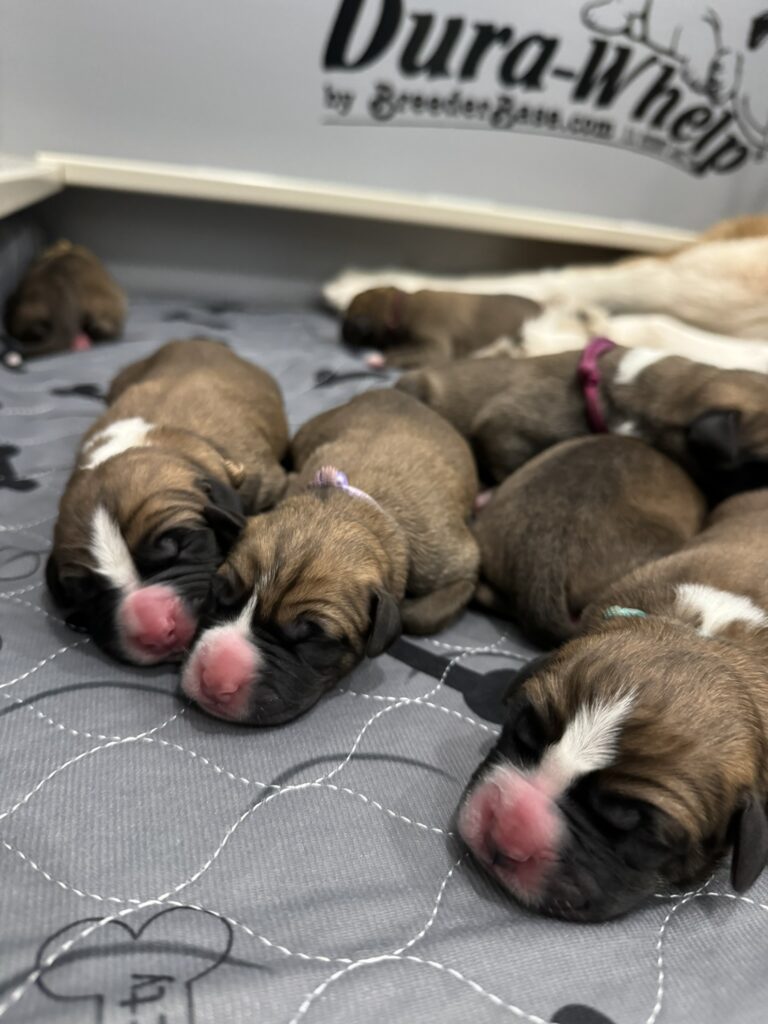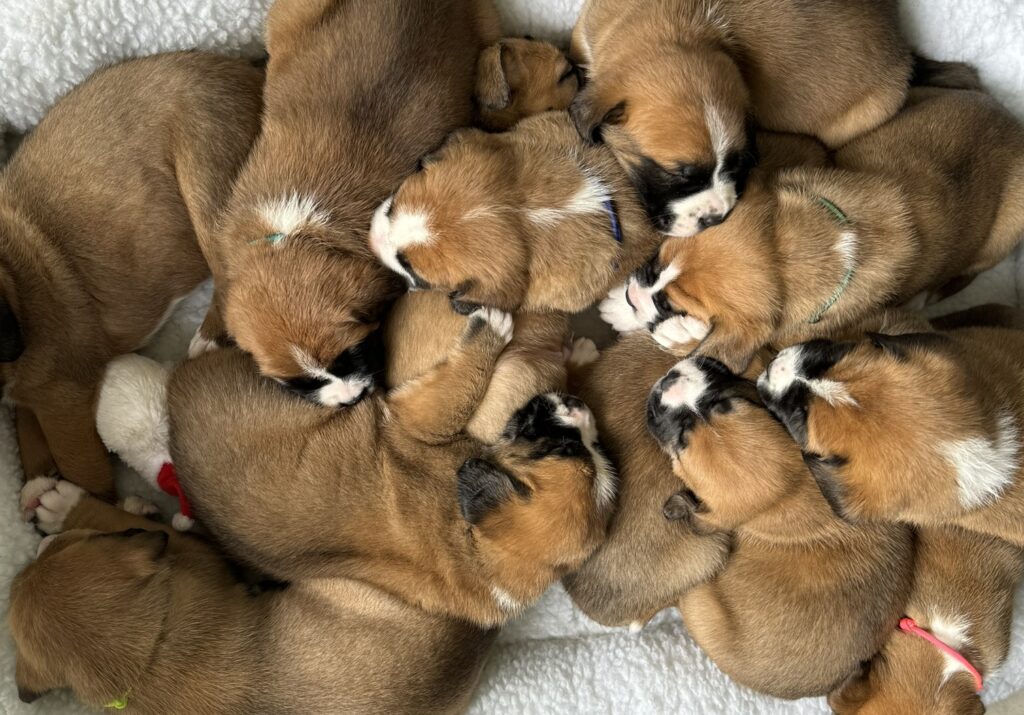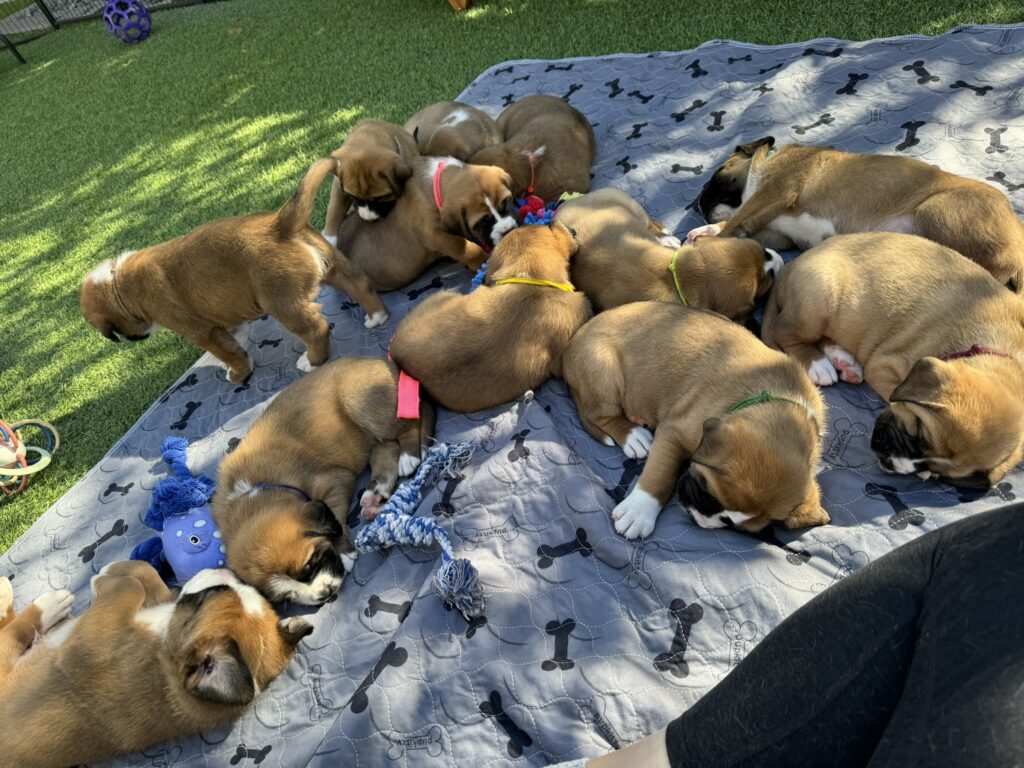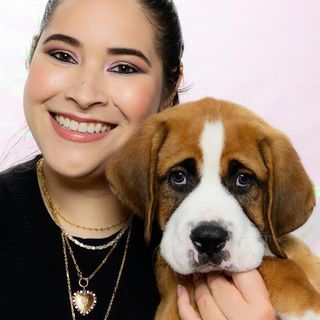There are five stages of growth that a puppy experiences before they become an adult. The stages can be generalized by age but often our responses have to be guided by the pup’s individual development rather exactly their age.1

Neonatal Stage (0-14 Days)
The Neonatal Stage begins as soon as the pup is born and goes through the first two weeks of its life. The mother should be the primary caretaker of her pups during this stage as they rely on her entirely. Puppies are born deaf and blind, so for the first two weeks, they spend most of their time eating and sleeping in order to develop further.
Mama dog should nurse frequently and leave the whelping area/box for brief periods to eat, drink, and potty. She will also stimulate her pups by licking their genitals for them to urinate and defecate (and she will consume both in order to keep the area clean).
Many breeders and behaviorists believe some form of handling is beneficial during the first two weeks of a pup’s life, but tangible benefits have been difficult to prove. Our position is that handling should be limited to daily care, including weighing and switching out linens, but as long as mom is actively caring for her pups, they do not need to be handled much by their human caretaker(s).
If the pups do not have a mom, gentle stroking to mimic mom’s care may be appropriate, but given that pups spend over 90% of their time sleeping, there’s no need to wake them up to provide handling.

Transitional Stage (14-28 Days)
The Transitional Stage starts when puppies open their eyes and become more cognizant of their littermates. This stage ends when their hearing comes in enough for them to be “startled” by a loud sound, and then the pups move into the Socialization Stage.
Some pups may be more or less developed, which can depend on the nutrition and care that mom received during pregnancy but also on the breed. Larger breed pups tend to develop more quickly physically, while smaller breed pups can be a bit slower.
It is key for human caretakers to observe the physical development of the pups in order to assess whether they’re still in the Transitional Stage or can move to the Socialization Stage.
Around three weeks, or 21 days of age, human caretakers can increase the handling to gentle stroking, light cuddling, and touching of extremities (ears, paws, and tail).

Socialization Stage (3-12 Weeks)
The Socialization Stage begins when pups can be startled by louder noises. This is a critical stage where new encounters and experiences with people, places, and things can have an effect on how the pup will react to them for the remainder of their life. Pups should be seeing, hearing, and walking at the start of this stage, and as they gain more mobility and improve their senses, they’ll start interacting with their environment more and more.
Socialization is not just meeting new people or even being people-friendly. Within socialization, there is familiarization, desensitization, and laying the ground work for our expectations for them in the future.
There is the Early Socialization period, which occurs typically between three and six-weeks of age. However, this period can end as early as five weeks or as late as 12 weeks depending on the breed.2

The Early Socialization period “ends” when pups enter the first fear period, which is when they’re able to feel real fear–prior, they don’t have the capacity to fear, which is why we can do a lot in the first few weeks of this stage.
Once a puppy indicates they’ve entered into a fear period, we have to be more sensitive to introducing experiences and be extra cautious to keep the introduction of stimuli as positive as possible. It is important to keep in mind that a puppy phases into and out of the fear period, which can last two to three weeks.
As you might expect, the start, intensity, and duration of the fear period can differ depending on the breed and individual puppy. This is why we always want to observe the puppy’s behavior and let the behavior be our guide rather than a specific age or time.
We continue to give the puppy new experiences, introduce new objects, and work to build their confidence throughout the Socialization Stage. We simply have to be more mindful of our introductions and the intensity during the fear period.

Juvenile Stage (3-6 Months)
The Socialization Stage builds the foundation of socialization but the Juvenile Stage is often determinant of the future behavior of the dog as an adult. Puppies start pushing their boundaries during this stage and getting their adult teeth, so formalized training and offering of appropriate enrichment are key.
This period is marked by physical development and increased activity, as pup’s sleep less and become more independent. It is critical for human caretakers to continue socializing their puppy but also to include formalized obedience.3
Obedience can be done through positive-reinforcement (through the use of rewarding with treats, toys, and/or praise) in teaching commands like sit, down, off, stay, come, and more. Ideally, this process should have started between eight and 10-weeks of age, which is when most puppies are capable of pairing behaviors with commands.
Many pups will voluntarily obey their owners until three to four months old, but as they test their boundaries, they need more structured training to ensure a well-adjusted adult companion.

Adolescent Stage (6-18 Months)
The Adolescent Stage starts as the dog approaches sexual maturity. Sexual maturity begins around six months of age but depends on the breed. Puppies will continue to test or push boundaries, may seem rebellious as they want to interact more and more with their environment or become more curious about the world they live in. It is important to continue to reinforce boundaries, provide mental and physical exercise, and try to reign in any undesired behaviors.
Puppies go through a second fear period between six and 14 months of age. Again, we must look at the individually puppy and its behavior to determine whether it is entering this second fear period or not. Like the first fear period, it typically lasts between two and three weeks.
There is less scientific evidence of how the second fear period works and some breeders record that puppies can go through multiple secondary fear periods during this stage.3
Footnotes
- Serpell J., Duffy D.L., Jagoe J.A. Becoming a dog: Early experience and the development of behavior. In: Serpell J., editor. The Domestic Dog: Its Evolution, Behavior and Interactions with People. 2nd ed. Cambridge University Press; Cambridge, UK: 2016. pp. 94–102. ↩︎
- Morrow, M., Ottobre, J., Ottobre, A., Neville, P., St-Pierre, N., Dreschel, N., Pate, J., Breed-Dependent Differences in the Onset of Fear-Related Avoidance Behavior in Puppies, Journal of Veterinary Behavior (2015), doi: 10.1016/j.jveb.2015.03.002. ↩︎
- Peterson, ME, Kutzler MA (eds): Small Animal Pediatrics. St. Louis, 2011, Elsevier. ↩︎






